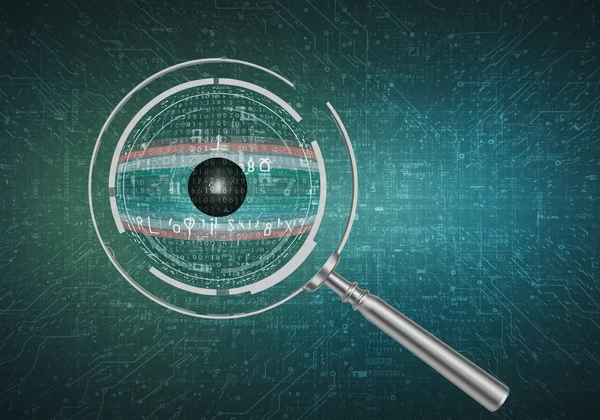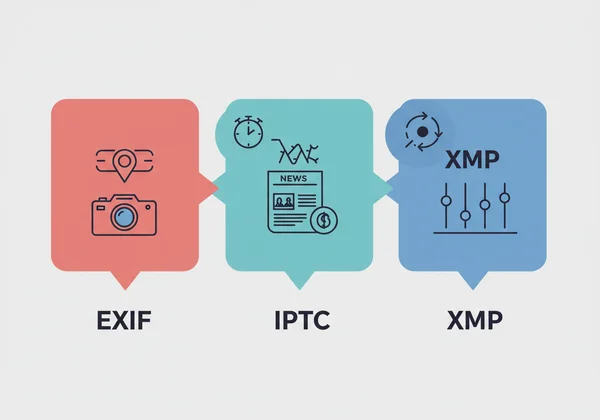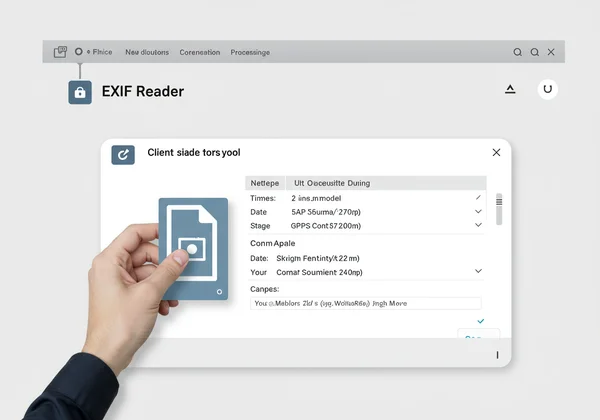Exif Reader: Protect Your Photo Privacy and Image Metadata
In our digital world, every photo we share tells a story. But beyond the pixels and colors, your images often carry a hidden narrative—a trove of data you may not even know exists. This data can reveal everything from the camera you used to the precise location where the photo was taken. The critical question for your photo privacy is this: Do you know what secrets your photos are sharing online?
Understanding and managing this hidden information, known as metadata, is no longer just for tech experts; it's an essential skill for anyone who shares photos online. This guide will walk you through the risks associated with image metadata and show you how to take control of your digital footprint with a powerful exif reader. The first step to protection is awareness, and you can view your image data safely in seconds.

What is Image Metadata & Why Photo Privacy Matters
Image metadata is text information embedded within an image file. It's automatically generated by your camera, smartphone, or photo editing software. While incredibly useful for organizing and analyzing photos, it can become a significant privacy concern if not managed correctly. Using an exif reader is the first step to understanding this data. Let's break down why this data deserves your attention.
The Hidden Details in Your Photos: EXIF, IPTC, and XMP
Metadata isn't a single block of text; it comes in several standard formats, each serving a different purpose. An exif reader is specifically designed to parse and display this information clearly.
-
EXIF (Exchangeable Image File Format): This is the most common type of metadata. It records technical details about the photo, such as the camera model, shutter speed, aperture, ISO settings, date, and time. Crucially, it can also include GPS coordinates.
-
IPTC (International Press Telecommunications Council): This standard is primarily used by journalists and photo agencies. It contains descriptive information, including headlines, captions, keywords, and copyright details. It helps verify the creator and context of an image.
-
XMP (Extensible Metadata Platform): Developed by Adobe, XMP is a more modern and flexible standard that can overlap with EXIF and IPTC. It can store a wide range of information, including edit history, ratings, and more complex data sets.

Unmasking Location: The Dangers of Geotagging in Your Pictures
Perhaps the most sensitive piece of metadata is the geotag. When your camera or smartphone's location services are enabled, the precise GPS coordinates of where you took a photo are embedded into the file's EXIF data.
Sharing a photo of your new pet at home could inadvertently broadcast your home address. A vacation picture might reveal when your house is empty. For privacy-conscious users, geotagging is a critical vulnerability that needs to be managed. An online exif reader can quickly show you if GPS data is present. You must know how to protect location data before you share any image.

Beyond Location: Other Sensitive Data at Risk
While geotags are the most obvious threat, other metadata points can be pieced together to build a detailed profile of your habits and equipment. For example, the unique serial number of your camera can be used to link different photos to you across various platforms, even if you post them anonymously. Timestamps can reveal your daily routines, and software details can expose the tools you use. A good exif reader can lay all this out for you.
Platform Risks: How Social Media & Sharing Affect Image Metadata Privacy
You might assume that the platforms you use are taking care of your privacy, but the reality is more complicated. The way your metadata is handled varies significantly from one service to another, creating potential risks you need to understand.
Do Social Media Platforms Remove EXIF Data?
This is one of the most common questions about photo privacy. Major platforms like Instagram, Facebook, and X (formerly Twitter) generally strip most EXIF data from the images displayed on their sites. They do this primarily to protect user privacy and to reduce file sizes.
However, this is not a foolproof security measure. You are still uploading the original file, with all its metadata, to their servers. Furthermore, policies can change, and smaller or less scrupulous websites may not remove this data at all, leaving you exposed. The only way to be certain is to check your photos yourself with a reliable online exif reader.
Online Marketplaces & Classifieds: Accidental Info Leaks
Think about selling a bike or some furniture online. You snap a few pictures in your garage or backyard and upload them to a site like Craigslist or Facebook Marketplace. If those photos contain geotags, you have just shown every potential buyer exactly where those valuable items are located. Using a quick exif reader before uploading could prevent this. This is a common scenario where accidental data leaks can lead to real-world security risks.
Best Practices for Secure Photo Sharing
True digital safety comes from proactive habits, not from relying on third-party platforms to protect you. Here are the essential best practices:

- Check Before You Share: Always review the metadata of any photo before you upload it anywhere.
- Turn Off Geotagging: If you don't need location data for your personal organization, consider turning off the location-tagging feature in your smartphone's camera app.
- Use a Secure Viewer: Employ a tool that respects your privacy. A client-side exif reader that processes images in your browser ensures your files are never uploaded to a server.
Adopting these practices empowers you to engage in secure photo sharing and protect your personal information.
How to Check and Manage Your Photo Metadata Safely
Now that you understand the risks, the next step is to take action. You need a simple, secure, and effective way to see exactly what data your images contain. Fortunately, you don't need to download any clunky software to do it.
Unveil Image Secrets: Using a Private Online EXIF Reader
The most critical factor when choosing a metadata viewer is privacy. Many online tools require you to upload your photos to their servers for analysis, which defeats the purpose of protecting your data. This is where our tool stands apart.
Our tool operates entirely on the client-side, meaning all the processing happens directly within your web browser. Your photo never leaves your computer. It is never uploaded, stored, or seen by anyone else. This privacy-by-design approach makes it the safest exif reader to use when you need to check exif data online.
Step-by-Step: Viewing Your Photo's Hidden Data Instantly
We've made the process incredibly simple. Here’s how you can inspect your photo's metadata in under a minute:
-
Visit the Homepage: Open your browser and go to our homepage.
-
Select Your Image: Drag and drop your image file directly onto the page, or click to browse and select a file from your computer.
-
Review the Data: Instantly, a comprehensive report appears. You can scroll through all the EXIF, IPTC, and other metadata, including camera settings, timestamps, and any GPS location data.

It's that easy. There's no sign-up, no software to install, and no privacy trade-offs. You can try our private tool right now.
Strategies for Removing or Editing Metadata
Our exif reader is designed to be a secure viewer—it empowers you with knowledge. While our tool does not edit or remove data, once you've identified sensitive information, you have several options for stripping it:
- Windows: Right-click the photo file, go to
Properties>Details, and clickRemove Properties and Personal Information. - Mac: Open the photo in the
Previewapp, go toTools>Show Inspector, and find theGPStab to remove location data. - Mobile Apps: Numerous third-party apps are available on both iOS and Android that are specifically designed to view and remove photo metadata.
Always create a copy of your photo before removing metadata, as the process is often irreversible.
Take Control of Your Digital Footprint with Our EXIF Reader
Your photos are a beautiful part of your digital life, and they should be shared with confidence, not fear. The hidden data they contain is a liability only when you are unaware of it. By understanding what metadata is, recognizing the risks, and using the right tools like a trusted exif reader, you can take definitive control over your personal information.
Knowledge is the first and most important step toward robust photo privacy. We invite you to make checking your metadata a regular part of your digital routine. Visit our exif reader today to safely and instantly unveil the secrets in your images and protect what matters most.
Frequently Asked Questions About Photo Privacy
Does EXIF data show location, and how can I protect it?
Yes, EXIF data absolutely can show the precise GPS location where a photo was taken if your camera's location services were active. To protect this data, you can either disable geotagging in your camera settings or use a secure tool like our online exif reader to check for location data before sharing the image.
Do screenshots have EXIF data that could reveal personal information?
Generally, screenshots do not contain the rich EXIF data that a camera-generated photo does. They typically lack GPS, camera model, and lens information. However, they do contain some metadata, such as the creation date, dimensions, and color profile, but are considered much lower risk from a privacy standpoint.
Do social media platforms like Facebook and Instagram remove EXIF data?
Most major social media platforms do strip EXIF data from photos when they are displayed publicly to protect users. However, the original file you upload to their servers still contains this data. For maximum security, it's always best to check and manage your metadata before uploading it anywhere.
What is the best free online EXIF viewer for ensuring photo privacy?
The best free online exif reader is one that prioritizes your privacy by processing images directly in your browser without uploading them to a server. Our tool is built on this client-side principle, ensuring your files never leave your computer, making it an ideal choice for anyone concerned with photo privacy.
How can I find the original metadata of a photo to check for privacy risks?
To find a photo's original metadata, you need a reliable exif data reader. Simply drag and drop your image file into the tool on the ExifReader.org homepage. It will instantly parse the file and display all embedded metadata, allowing you to quickly identify any potential privacy risks like location tags.